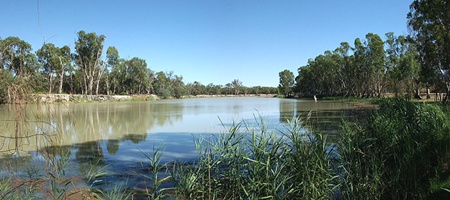Shiraz has been described by wine-writer Karen MacNeil as, “rustic, manly and yet elegant.” She must have written those words quite a few years ago because today, new-style Shiraz wines have shaken off their rustic image and have tended to become more suave and sophisticated. Whether this is actually a good thing is very much open to question, but the wine industry is highly competitive and many producers may have drawn the conclusion that few people these days want to drink rustic wines.
The spiritual home of Shiraz (SHEE-raz) is in France’s northern Rhône valley, just south of Lyon. This dark-skinned grape has been growing there since Roman times and still known by its original name, the Syrah (see-RAH). New World Shiraz grapes tend to make fruitier, more powerful aromatic wines than their French cousins. Over the years, Australia has taken Shiraz to heart and produces some very fine examples of great intensity using grapes from some of the oldest Shiraz vines in the world.
 The Murray River, near Loxton (Photo: Dwayne Madden)
The Murray River, near Loxton (Photo: Dwayne Madden)
Shiraz probably originated in the Middle East, although no one seems to be really certain and there are several different legends about its origin. At its best, the grape can produce dark, almost dramatic, earthy wines that tend to have a fair dose of tannin. The wines are usually powerful and fruity, overlaid with the characteristic tastes of pepper and spice.
Rook’s Lane Shiraz 2010 (red), Australia (Bt. 399 @Wine Connection)
It’s surprising that so many wines are named after birds. Why this should be, I have no idea but there are Laughing Kookaburra wines from Australia, Yali wines from Chile and Blackbird wines from Napa in California. Not surprisingly, the company motto is “Buy, Buy Blackbird”. Whistling Duck wines hail from New South Wales and if you search long enough you might come across Humming Bird Cabernet Sauvignon, The Secretary Bird Old Vine Cinsault and The Magnificent Crowing Cockerel Grenache-Syrah-Mourvèdre, which if you ask me is taking things a bit far. There are probably dozens more wines named after birds but I don’t suppose for a moment that you want me to make a list of them. (Funny you should mention that – Ed.)
Anyway, this brings me to rooks, or more specifically Rook’s Lane wines, which hail from the Murray Darling wine region in Victoria’s North-West. This vast area is named after its two major rivers, the Murray River and the Darling River. Dark red and inviting, this wine has a concentrated, sweet aroma of ripe black fruits, especially black cherries, blackberries, herbs, mint and a faint reminder of chocolate. A little later in the smelling session (for mine are always rather prolonged) the characteristic spicy and peppery Shiraz aromas come through as well as a hint of vanilla. If all this sounds a bit fanciful, these terms of description are quite common for Shiraz. It’s a complex aroma considering the price of the wine, and smells a good deal more expensive than it actually is. One website claims that the wine also has the aroma of mulberries, but quite honestly I can’t remember what a mulberry smells like.
There’s a very smooth mouth-feel and the flavour is packed with fruit, giving it a sense of sweetness. There’s also an attractive dash of acidity and a framework of soft tannins which help to give the wine a sense of balance. It’s light-to-medium bodied and there’s a persistent fruity and herb-like finish and in many ways it’s a well-crafted wine with a touch of elegance. One Australian reviewer wrote, “Dollar for dollar, this is as good as it gets….the nose is all ripe berries, black cherries, vanilla and spice…flavours are rich and juicy and there is a nice savoury aftertaste to the proceedings.”
As circumstances would have it, I found myself drinking some of the wine later in the evening with a home-made pizza turbo-charged with capers, spicy salami and bits of those hot little red prik dairng Thai peppers. The food and the wine matched perfectly and I am sure the dogs would have agreed, but they’re not terribly keen on hot red peppers.
Castle Creek Shiraz 2011 (red), Australia (Bt. 489 @ Big C)
I tasted the 2010 vintage of this wine a couple of years ago when it cost a mere Bt. 349 for a bottle. It’s interesting to revisit wines from time to time and in the case of European wines it’s fairly essential because the climate there is so unpredictable. A wine from a particular château in Bordeaux or a particular estate in Burgundy can taste significantly different from one year to the next. New World vines don’t usually have to tolerate dramatic changes in the weather and commercial wines blended for consistency remain much the same from year to year. Nonetheless, revisiting a wine can be quite revealing because your perception of the wine might be different. Sometimes, the wine itself hasn’t changed very much; but you have.
This wine looks tempting enough in the glass, with its bright ruby-red colour and thick syrupy-looking legs. There’s a huge fruity aroma with blackberry, black cherry, and a dash of mint with the pepper and spices out in force. The mouth-feel is amazingly soft and silky with bags of dark fruit on the palate, no discernable acidity and very soft, supple tannins. The wine is really quite dry but it’s balanced by the sweetness of the fruit. There’s a long, spicy finish too and in some ways, this is a typical Big Ozzie Shiraz but it also has a soft and beguiling touch. I wouldn’t describe it as elegant, but it certainly exudes warmth and a kind of homely charm.
Even if you are one of those people who claim to prefer their reds at “room temperature” (which is too vague an expression to be of much practical value) I’d suggest that you drink this wine on the cool side. Why? Because the cooler temperature will bring the tannins forward a little and will make the wine feel firmer. It will also tighten up the aromas and taste. Served warm, the wine will seem flabby and shapeless. It will also feel slightly unbalanced, a bit like me after a convivial evening down at the bar.
Out of curiosity, I checked my barely-legible tasting notes for the 2010 vintage and it really does seem that the 2011 has more fullness and depth. The flavours seem more intense, the aroma richer and the texture softer. Alright, it might just be that my perception of the wine has changed, but if you like a big, generous and fruity red, give this one a try.
Shiraz makes an excellent food partner and this particular wine would go well with undemanding meat dishes like beef burgers, sausages or other barbecued delights. One of Australia’s top wine-makers suggests that their local Shiraz goes perfectly with char-grilled kangaroo steaks, but I shall have to take his word for that. Just don’t drink it with fish and chips.




